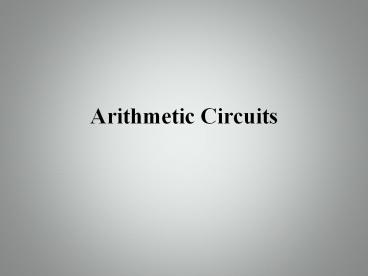Arithmetic Circuits - PowerPoint PPT Presentation
Title:
Arithmetic Circuits
Description:
Arithmetic Circuits * Half Adder A B Sum Carry 0 0 0 0 0 1 1 0 1 0 1 0 1 1 0 1 Half Adder Full Adder A B Cin Sum Cout 0 0 0 0 0 0 0 1 1 0 0 1 0 1 0 0 1 1 0 1 1 0 0 1 ... – PowerPoint PPT presentation
Number of Views:518
Avg rating:3.0/5.0
Title: Arithmetic Circuits
1
Arithmetic Circuits
2
Half Adder
A B Sum Carry
0 0 0 0
0 1 1 0
1 0 1 0
1 1 0 1
3
Half Adder
4
Full Adder
A B Cin Sum Cout
0 0 0 0 0
0 0 1 1 0
0 1 0 1 0
0 1 1 0 1
1 0 0 1 0
1 0 1 0 1
1 1 0 0 1
1 1 1 1 1
5
Full Adder
6
Implementing a Full adder using two half adders
7
Parallel Binary Adder
8
Parallel Binary adder Two Numbers X Y Each
number is represented using 6 bits.
XXoX1X2X3X4X5 YYoY1Y2Y3Y4Y5
9
Complete Parallel Adder With Registers
- D Flip-flops are used to save a single bit
- A number of D flip-flops are connected in a way
to form the binary number, where each bit of that
number is saved in a single D flip-flop.
10
(No Transcript)
11
Example Sequence of operations in Adding 1001
and 0101
- 1) A 0000. A CLEAR pulse is applied to CLR
of each FF on register A at t1. - 2) M ? B. The first binary number 1001 is
transferred from memory to B register on the PGT
of the LOAD pulse at t2. - 3) S ? A. With B 1001 and A 0000,
the full adders produce a sum of 1001 which is
transferred to A register on the PGT of the
TRANSFER pulse at t3. This makes A 1001. - 4) M ? B. The second binary number 0101 is
transferred from memory to B register on the PGT
of the second LOAD pulse at t4. This makes B
0101. - 5) S ? A. With B 0101 and A 1001,
the full adders produce a sum of 1110 which is
transferred to A register on the PGT of the
second TRANSFER pulse at t5. This makes A
1110.
12
Integrated Circuit Parallel Adder( IC Parallel
Adder )4- Bits adder
13
8 Bit IC Parallel Adder
14
BCD Adder
15
BCD Adder
- When the sum of two digits is less than or equal
to 9 then the ordinary 4-bit adder can be used - But if the sum of two digits is greater than 9
then a correction must be added I.e adding 0110 - We need to design a circuit that is capable of
doing the correct addition
16
BCD Adder
- The cases where the sum of two 4-bit numbers is
greater than 9 are in the following table
S4 S3 S2 S1 S0
0 1 0 1 0 10
0 1 0 1 1 11
0 1 1 0 0 12
0 1 1 0 1 13
0 1 1 1 0 14
0 1 1 1 1 15
1 0 0 0 0 16
1 0 0 0 1 17
1 0 0 1 0 18
17
BCD Adder
- Whenever S41 (sums greater than 15)
- Whenever S31 and either S2 or S1 or both are 1
(sums 10 to 15) - The previous table can be expressed as
- X S4 S3 ( S2 S1)
- So, whenever X 1 we should add a correction of
0110 to the sum.
18
InputsA0101, B 0011, Co0
0011
0101
0 1 0 0 0
0
0
0
1000
1
1 0 0 0
0000
19
InputsA0111, B 0110, Co0
0110
0111
0 1 1 0 1
1
1
1
1101
1
0 0 1 1
0110
20
Cascading BCD Adders
- The previous circuit is used for adding two
decimal digits only. That is, 7 6 13. - For adding numbers with several digits, a
separate BCD adder for each digit position must
be used. - For example
- 2 4 7
- 5 3 8
- --------------------
- ?
21
Cascading BCD Adders
22
Example
- Determine the inputs and the outputs when the
above circuit is used to add 538 to 247. Assume a
CARRY IN 0 - Solution
- Represent the decimal numbers in BCD
- 247 0010 0100 0111
- 538 0101 0011 1000
- Put these numbers in registers A and B
- A 0010 0100 0111
- B 0101 0011 1000
23
Example































